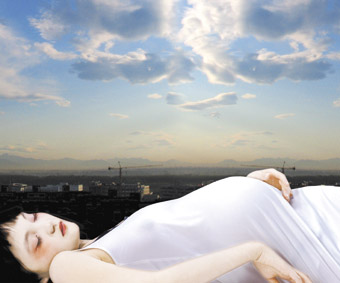screen worlds
robert lort explores the vernacular terrain at QUT

Cui Xiuwen, Angel Series #13
courtesy of the artist and Marella Gallery, Beijing
Cui Xiuwen, Angel Series #13
ENTERING THE QUT CREATIVE INDUSTRIES PRECINCT I WAS CONFRONTED BY A CONFLUENCE OF SCREENS, EACH OUT TO GRAB MY ATTENTION. DAZZLED, I TEETERED ABOUT UNSURE WHICH WAY TO TURN. THE VERNACULAR TERRAIN EXHIBITION FEATURED 50 ARTISTS FROM AUSTRALIA, CHINA AND JAPAN AND WAS CURATED BY A TEAM LED BY STEPHEN DANZIGER, THE DIRECTOR OF IDA (INTERNATIONAL DIGITAL ART) PROJECTS. IT RESPONDED TO THE IDEA OF ‘VERNACULAR CREATIVITY’ AS COINED BY MEDIA THEORIST JEAN BURGESS, REFERRING TO COMMONPLACE MODES OF CREATION.
With the increasing availability of digital media technologies this creativity is being nurtured in a plethora of new contexts and modes of social interaction, as exemplified by YouTube, Flickr, mobile phone art, Second Life and the neverending torrent of blogs. As the new digital terrain becomes at once both domestic and global, Marshall McLuhan’s mistyped catch phrase “the medium is the massage” looms louder than ever.
The majority of the works in Vernacular Terrain were screen-based. Perhaps non-screen-based works, being dependent on different platforms or on interfaces for interaction, are less attractive to artists because of technical obstacles and limitations of distribution.
Projected onto one wall was Taiwanese artist Chen Yung-Hsien’s Grassing. A plasticine bust of the artist’s head, shorn of hair, eyes closed, evoking transcendence. Rice seeds sprinkled onto the head take root and grow. With time lapse filming, the head is transformed into a mass of leafy green shoots, like a green mohawk. A period of illness spawned for the artist a whole series of works focused on his head, beginning with Release, which involved wrapping it in bacon and salmon strips. The impression is of the need to find tranquility—if by curious means—more usually associated with nature rather than technology.
In the work of Kim Joon (Korea) tattoos come to life on human skin: Chinese characters swell and breathe, while tattooed soldiers steam and explode in jittery motion. The idea came from the artist’s animated tattoo designs for mobile phone screen savers. The work is quite controverisal because tattooing in Korea is still essentially illegal unless the tattooist has a medical degree. Kim Joon associates tattoos with desire, wounded masculinity and processes of imprinting memory. In other works he has used commercial brand labels as oversized tattoos in a critique of consumer obsession with logos.
Almost concealed by the array of massive screens was a set of high-tech glasses through which I viewed the R-rated works of Faiyaz Jafri. These featured animated porcelain doll characters as sadistic “plastic surgery vixens” with fingerless elongated limbs. These nymphs play out bloody Japanese horror scenarios set against computer game generated hallways and rooms. In Déjeuner, a posse of knife wielding girls forms 3D virtual spaces, one inside another. Although Jafri is of Pakistani descent, he grew up in the Netherlands and now lives in New York, and his work reveals its transcultural character in the influence of the Japanese Hentai (perverted sexuality) tradition found these days in anime and manga.
The Australian animator Chris Denaro was artist in residence, developing a new work every 72 hours which was then projected onto the floor. By delving into the endless realm of images available on the photo sharing site Flickr and using a Creative Commons licensed software tool, Denaro collected images of objects, particularly those with over-designed curvilinear design. Splicing them together he formed entirely new objects which had little resemblance to the originals. These new objects resembled Japanese Chindogu (possibly useless inventions) in all their absurdity. The animation software then looped the chimerical forms into mechanised animations allowing them to dance and spin around the floor.
Jin Shan’s video, Hanging Flesh (China), takes us inside a deserted industrial warehouse with long tracking shots. We finally encounter a shirtless figure swaying pendulum-like to an accompanying soundtrack of animal squeals. The viewer soon realises, however, that the camera is inverted. With this image of apparent torment Jin responds grimly to the relentless, dehumanising transformation of modern China.
Other works included Peter Greenaway and collaborator Istvan Horkay’s latest extension of their Tulse Luper project. The high level of sophistication of that work possibly departed from the vernacular theme, but it further revealed how multiple images can be framed, overlayed and threaded through with multiple narratives, not unlike HTML.
Many artists are now taking up the opportunities offered by new media to circumvent the usual gate keepers to reach audiences outside the gallery context. The increasing democratisation offered by online communities contrasts with the fast eroding democracy of established media outlets. The new vernacular aesthetic is already noticeably infiltrating big media in the form of reality TV, homespun documentaries and fake B grade movies. Tom Sherman of Vernacular Video trumpets the death knell for artists who hesitate to immerse themselves in the aesthetic of this latest vernacular. He may yet be mistaken. What is apparent is that many of these works from around the world seek not only to respond to the fast paced, low-fi buzz of the vernacular with more sophisticated and enriching alternatives, but also seek to escape and transcend the popular vernacular itself and still reach an audience.
***
Photographer and video artist Cui Xiuwen (born 1970) exhibits internationally and has been a leader in bringing the female artist in China to prominence, boldly focusing on sex, previously the province of the male artist. In her digital photographic series Angel, young girls in white, the one here pregnant, populate the modern Chinese landscape. [Ed.]
IDA Projects, Vernacular Terrain, curators Stephen Danziger, Xu Dawei, Lubi Thomas, Michael Perkins, Pauline Doutreluingne; presented by QUT Creative Industries Precinct and Beijing Film Academy in association with Yokohama Art Project and Platform China Contemporary Art Insititute, QUT Creative Industries Precinct Aug 28-Sept 15, QUT Art Museum, Brisbane, Aug 1-Sept 30; http://www.idaprojects.org/
RealTime issue #81 Oct-Nov 2007 pg. 29






